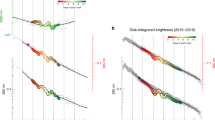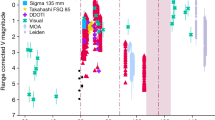Abstract
One of the most important considerations when planning the next generation of ground-based optical astronomical telescopes is to choose a site that has excellent ‘seeing’—the jitter in the apparent position of a star that is caused by light bending as it passes through regions of differing refractive index in the Earth's atmosphere. The best mid-latitude sites have a median seeing ranging from 0.5 to 1.0 arcsec (refs 1–5). Sites on the Antarctic plateau have unique atmospheric properties that make them worth investigating as potential observatory locations. Previous testing at the US Amundsen-Scott South Pole Station has, however, demonstrated poor seeing, averaging 1.8 arcsec (refs 6, 7). Here we report observations of the wintertime seeing from Dome C (ref. 8), a high point on the Antarctic plateau at a latitude of 75° S. The results are remarkable: the median seeing is 0.27 arcsec, and below 0.15 arcsec 25 per cent of the time. A telescope placed at Dome C would compete with one that is 2 to 3 times larger at the best mid-latitude observatories, and an interferometer based at this site could work on projects that would otherwise require a space mission.
This is a preview of subscription content, access via your institution
Access options
Subscribe to this journal
Receive 51 print issues and online access
$199.00 per year
only $3.90 per issue
Buy this article
- Purchase on Springer Link
- Instant access to full article PDF
Prices may be subject to local taxes which are calculated during checkout



Similar content being viewed by others
References
Racine, R. & Ellerbroek, B. L. Profiles of the night-time turbulence above Mauna Kea and isoplanatism extension in adaptive optics. Proc. SPIE 2534, 248–257 (1995)
Sarazin, M. Astroclimatology of Paranal (European Southern Observatory, 1999); 〈http://www.eso.org/gen-fac/pubs/astclim/paranal/index.html〉 (1999).
Michel, R., Echevarria, J., Costero, R. & Harris, O. The seeing at San Pedro Mártir Observatory as measured using the DIMM method. Rev. Mex. Astron. Astrofís. 19, 37–40 (2003)
National Astronomical Observatory of Japan. Subaru telescope seeing 〈http://www.naoj.org/Observing/Telescope/Image/seeing.html〉 (2003).
Muñoz-Tuñón, C., Vernin, J. & Varela, A. M. Night-time image quality at Roque de los Muchachos Observatory. Astron. Astrophys. Suppl. Ser. 125, 183–193 (1997)
Travouillon, T. et al. Automated Shack-Hartmann seeing measurements at the South Pole. Astron. Astrophys. 409, 1169–1173 (2003)
Marks, R. D., Vernin, J., Azouit, M., Manigault, J. F. & Clevelin, C. Measurement of optical seeing on the high Antarctic plateau. Astron. Astrophys. Suppl. Ser. 134, 161–172 (1999)
Candidi, M. & Lori, A. Status of the Antarctic base at Dome C and perspectives for Astrophysics. Mem. Soc. Astron. Ital. 74, 29–37 (2003)
Ashley, M. C. B. et al. South Pole observations of the near-infrared sky brightness. Pub. Astron. Soc. Pacif. 108, 721–723 (1996)
Chamberlain, M. A. et al. Mid-infrared observing conditions at the South Pole. Astrophys. J. 535, 501–511 (2000)
Chamberlin, R. A. & Bally, J. 225-GHz atmospheric opacity of the South Pole sky derived from continual radiometric measurements of the sky-brightness temperature. Appl. Opt. 33, 1095–1099 (1994)
Travouillon, T., Ashey, M. C. B., Burton, M. G., Storey, J. W. V. & Lowenstein, R. F. Atmospheric turbulence at the South Pole and its implications for astronomy. Astron. Astrophys. 400, 1163–1172 (2002)
Gillingham, P. R. Super seeing from the Australian Antarctic Territory? ANARE Res. Notes 88, 290–292 (1993)
Marks, R. D. Astronomical seeing from the summits of the Antarctic plateau. Astron. Astrophys. 385, 328–336 (2002)
Aristidi, E. et al. Antarctic site testing: first daily seeing monitoring at Dome C. Astron. Astrophys. 406, L19–L22 (2003)
Aristidi, E. et al. Preliminary summer site testing study based on weather balloons at Dome C, Antarctica. Astron. Astrophys. (submitted)
Lawrence, J. S., Ashley, M. C. B. & Storey, J. W. V. A remote, autonomous laboratory for Antarctica with hybrid power generation. J. Electron. Electric. Eng. Aust. (in the press)
Kornilov, V. et al. MASS: a monitor of the vertical turbulence distribution. Proc. SPIE 4839, 837–845 (2003)
Tokovinin, A., Baumont, S. & Vasquez, J. Statistics of turbulence profile at Cerro Tololo. Mon. Not. R. Astron. Soc. 340, 52–58 (2003)
Tokovinin, A., Kornilov, V., Shatsky, N. & Voziakova, O. Restoration of turbulence profile from scintillation indices. Mon. Not. R. Astron. Soc. 343, 891–899 (2003)
Tokovinin, A. Measurement of seeing and atmospheric time constant by differential scintillations. Appl. Opt. 41, 957–964 (2002)
Travouillon, T., Burton, M. G., Storey, J. W. V., Vernin, J. & Azouit, M. Comparison and cross-calibration of SODAR and microthermal sensor results. Geophys. Res. Lett. (submitted)
Chanin, M. An exceptional situation in the Antarctic stratosphere in 2002. Mem. Soc. Astron. Ital. Suppl. 2, 19–25 (2003)
Ellerbroek, B. L. & Tyler, D. W. Adaptive optics sky coverage calculations for the Gemini-North telescope. Publ. Astron. Soc. Pacif. 110, 165–185 (1998)
Beckers, J. M. Adaptive optics for astronomy: principles, performance, and applications. Annu. Rev. Astron. Astrophys. 31, 13–62 (1993)
Ashley, M. C. B., Burton, M. G., Calisse, P. G., Phillips, A. & Storey, J. W. V. Site testing at Dome C—cloud statistics from the ICECAM experiment. Highlights of Astronomy (ASP Conf. Ser. Vol. 13, Astronomical Society of the Pacific, in the press)
Lawrence, J. S. Infrared and submillimeter atmospheric characteristics of high Antarctic Plateau sites. Publ. Astron. Soc. Pacif. 116, 482–492 (2004)
National Optical Astronomy Observatory. MASS data access 〈http://139.229.11.21/massindex.php?Submit2=MASS+Database〉 (2004).
Avila, R. et al. Optical turbulence and wind profiles at San Pedro Martir. Rev. Mex. Astron. Astrofís. 19, 11–22 (2003)
Vernin, J. & Muñoz-Tuñón, C. Optical seeing at La Palma Observatory. II. Intensive site testing campaign at the Nordic Optical Telescope. Astron. Astrophys. 284, 311–318 (1994)
Acknowledgements
The AASTINO project is supported by the Australian Research Council, the Australian Antarctic Division, the French and Italian Antarctic research programs (IPEV, PNRA) and the US National Science Foundation. The Dome C MASS is a collaboration between UNSW, CTIO and JPL. We thank J. Storey, A. Moore and C. Bonner for contributions during Dome C deployments; J. Storey, M. Swain, J. Lloyd, and J. Everett for intellectual input into the Dome C MASS project; S. Kenyon for assistance with data analysis; and V. Kornilov and N. Shatsky for software support of MASS. We also thank P. Gillingham for his encouragement over the past decade to demonstrate the existence of exceptional seeing from the Antarctic plateau.Authors' contributions J.S.L. and M.C.B.A. designed and operated the Antarctic MASS instrumentation and co-wrote this Letter. A.T. provided the MASS sensor in collaboration with V. Kornilov et al. and assisted with the data analysis. T.T. assisted with the SODAR data and installation of MASS at Dome C.
Author information
Authors and Affiliations
Corresponding author
Ethics declarations
Competing interests
The authors declare that they have no competing financial interests.
Rights and permissions
About this article
Cite this article
Lawrence, J., Ashley, M., Tokovinin, A. et al. Exceptional astronomical seeing conditions above Dome C in Antarctica. Nature 431, 278–281 (2004). https://doi.org/10.1038/nature02929
Received:
Accepted:
Issue Date:
DOI: https://doi.org/10.1038/nature02929
This article is cited by
-
Lenghu on the Tibetan Plateau as an astronomical observing site
Nature (2021)
-
Night-time measurements of astronomical seeing at Dome A in Antarctica
Nature (2020)
-
Preliminary site selection for an observatory in the Egyptian Eastern Desert
Astrophysics and Space Science (2019)
-
Application of a regional model to astronomical site testing in western Antarctica
Theoretical and Applied Climatology (2016)
-
Search for an astronomical site in Kenya (SASKYA) using climate reanalyses and high-resolution meteorological model data
Theoretical and Applied Climatology (2016)
Comments
By submitting a comment you agree to abide by our Terms and Community Guidelines. If you find something abusive or that does not comply with our terms or guidelines please flag it as inappropriate.



